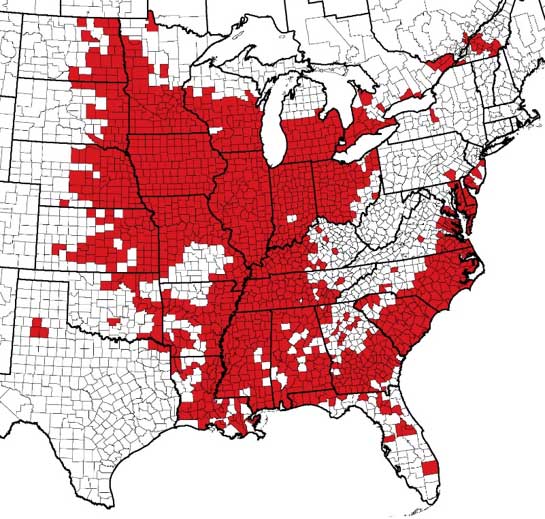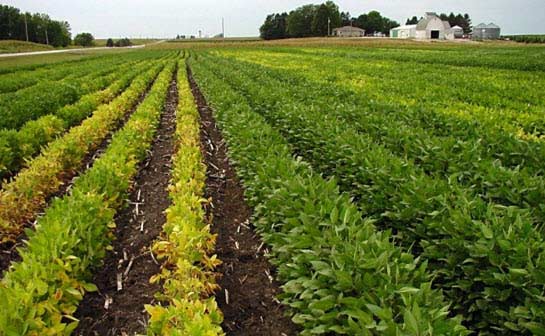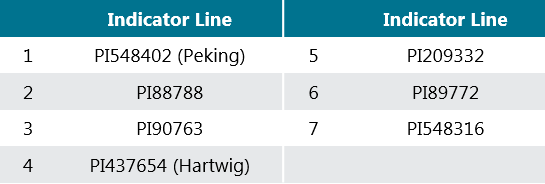Soybean Cyst Nematode in North America
- Soybean cyst nematode (SCN; Heterodera glycines) is a major yield-reducing pathogen of soybean production in North America.
- SCN was likely introduced to the U.S. from Japan. The first report of SCN in the U.S. was in North Carolina in 1954.
- This tiny worm-like parasite has now spread to practically all important soybean production areas of the U.S. and Canada (Figure 1), and is reaching economic levels in more areas.
- SCN may decrease yields substantially without inducing obvious symptoms. Studies have shown that in SCN-infested fields, yields can be reduced by over 30 percent without visible above-ground symptoms.

Figure 1. Known distribution of soybean cyst nematode in the United States and Canada as of 2017 (from Marett and Tylke, 2017).
Genetic Resistance to SCN
- The most important management tactic for SCN during the years since its establishment as a yield-limiting pest in North America has been selection of soybean varieties with genetic resistance to SCN (Figure 2).
- Researchers have identified a number of soybean lines that have the ability to resist nematode reproduction on their roots.
- Currently, there are three main sources for genetic resistance to SCN in commercially-available soybean varieties - PI88788, PI548402 (Peking), and PI437654 (Hartwig and CystX).
- The PI 88788 source is used in the vast majority of existing SCN-resistant varieties marketed in the US.
- Only a small number of varieties currently use the PI548402 (Peking) source, and even fewer use the PI437654 source.

Figure 2. Strips of SCN-resistant and non-resistant soybean varieties in a SCN-infested field, showing damage to the non-resistant varieties.
SCN HG Types
- SCN populations are genetically diverse and have historically been separated into races by their ability to reproduce on soybean tester lines.
- The most commonly used system separated SCN into 16 races.
- More recently, a new classification system called the HG Type test has been widely adopted. The HG Type test is similar to a SCN race test, but includes only the seven sources of resistance in available SCN-resistant soybean varieties.
- Results are shown as a percentage, indicating how much the nematode population from a soil sample increased on each of the seven lines.
- The HG Type test indicates which sources of resistance would be suited for the field being tested. For example, if an HG type contains the number 2, this indicates that PI88788 would not be an effective source of SCN resistance (Table 1).
Table 1. Indicator lines for HG Type classification of SCN.

Decreased Efficacy of PI88788 Resistance
- Beginning in the 1990s, the widespread availability of soybean varieties with PI88788 SCN resistance provided a largely effective management tool for SCN in North America.
- In recent years however, PI88788 has been losing its effectiveness as a SCN management tool.
- A recent survey in Nebraska showed almost half (47%) of the fields tested had SCN populations that reproduced on PI 88788 (HG type 2) (Wilson, 2018).
- A recent University of Missouri study of 28 SCN populations representing different regions of the state found that all of them showed reproduction on PI 88788 varieties (Mitchum and Howland, 2018).
- Studies in other states have found similar results, showing that SCN populations able to reproduce on PI88788 varieties have become widespread in many areas.
- The PI88788 source of SCN resistance no longer provides effective control in many fields, meaning that SCN once again poses a significant threat to soybean yield that requires grower attention and management.
SCN Management Recommendations
- The SCN Coalition provides the following recommendations for developing a plan to manage SCN:
- Test your fields to know your numbers
- Rotate resistant varieties
- Rotate to non-host crops
- Consider using a nematode protectant seed treatment
- Consult your university soybean extension specialist for specific management recommendations for your state.
Test Your Fields
- The first step in developing a SCN management plan is testing fields to determine the presence of SCN and/or the HG type of the population. Soybean specialists now recommend retesting infested fields every six years.
- Sample at the same time of year and following the same crop each time – SCN populations vary during the growing season and in response to host and non-host crops.
- Limit the area represented in a single sample to 10-20 acres to increase accuracy of results.
- Use a soil probe, a small shovel, or a trowel to collect samples. Collect soil to a depth of 6-8 inches in the root zone of plants.
- Collect 10-20 “cores” with the probe, or 10-20 ¼-cup samples with the shovel or trowel. Representative sampling is best achieved by collecting subsamples in a zigzag pattern across the entire sample area.
- Some universities recommend sampling markedly different soil textures separately. Also, areas with different cropping histories should be sampled separately.
- Deposit subsamples in a bucket and mix thoroughly. Place about 2 cups of soil in a plastic bag and label with a permanent marker. Paper bags allow soil to dry excessively and are not recommended for SCN.
- Do not store samples in direct sun or allow them to overheat. Ship as soon as possible to the lab you choose.
Rotate Resistant Varieties
- If your SCN populations are found to be increasing, select varieties with sources of resistance other than PI88788.
- The most common source of resistance other than PI88788 is PI548402 or “Peking” resistance.
- The Peking source of SCN resistance was identified from an older soybean cultivar and has been associated with yield drag.
- Pioneer has been using precision molecular breeding methods to isolate the Peking genes and eliminate yield drag associated with the trait.
- As a leader in SCN breeding, we continue to breed with Peking and Hartwig sources of resistance to provide additional modes of action for a variety of SCN races.
- The complexity of the Hartwig trait makes it more challenging to bring into high yield potential varieties, but Pioneer anticipates introducing new varieties with the Hartwig source in the next few years.
Rotate to Non-Host Crops
- Rotation to a non-host crop to reduce SCN pressure.
- Corn, alfalfa and small grains are the most common non-crop choices for reducing SCN numbers.
- Since SCN persists in the soil for many years, however; it cannot be totally eradicated by rotation.
Seed Treatments
- Several nematicide seed treatments with activity against SCN are currently available and can provide added protection when used with a SCN-resistant soybean variety.
- Nematicide seed treatments are intended to supplement current SCN management strategies, not replace them. Seed treatments should therefore be used in coordination with SCN-resistant varieties and rotation to non-host crops (Bissonnette and Tylka, 2017).
- The LumiGEN™ system offering includes ILEVO® fungicide/nematicide seed treatment, which has activity against SCN.
- A Pioneer study including 193 on-farm trial locations found an average yield response of 4.9 bu/acre in high SCN fields when ILEVO fungicide/nematicide seed treatment was added to the standard fungicide and insecticide seed treatment package (O’Bryan and Burnison, 2016).
References
- Bissonnette, K.M., and G.L. Tylka. 2017. Seed Treatments for Soybean Cyst Nematode. Iowa State University Extension. Crop 3142.
- Mitchum, M.G., and A. Howland. 2018. Distribution, Levels, and HG Types of SCN Populations in Missouri. Pioneer Agronomy Research Update.
- O’Bryan, K., and M. Burnison. 2016. Performance of Soybean Seed Treatments Against SDS and SCN in On-Farm Trials. Pioneer Agronomy Research Update.
- Tylka, G. 2018. Reflecting on SCN in Iowa Through the Years. Iowa State University Extension Integrated Crop Management News.
- Wilson, J. 2018. New Methods Needed to Manage SCN in Soybean. University of Nebraska-Lincoln Cropwatch.


Components of LumiGEN™ technologies for soybeans are applied at a Corteva Agriscience production facility, or by an independent sales representative of Corteva Agriscience or its affiliates. Not all sales representatives offer treatment services, and costs and other charges may vary. See your sales representative for details. Seed applied technologies exclusive to Corteva Agriscience and its affiliates. ILEVO® is a registered trademarks of BASF.
The foregoing is provided for informational use only. Please contact your Pioneer sales professional for information and suggestions specific to your operation. Product performance is variable and depends on many factors such as moisture and heat stress, soil type, management practices and environmental stress as well as disease and pest pressures. Individual results may vary. Pioneer® brand products are provided subject to the terms and conditions of purchase which are part of the labeling and purchase documents.
Author: Mark Jeschke
February 2020